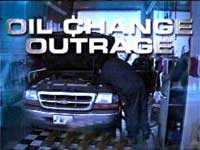Motor oil is designed to serve many different purposes within a cars engine. While the primary function is to simply lubricate all the moving parts and provide protection from wear and corrosion, it also is intended to keep the engine cool and free from small pieces of debris. Conventional motor oils are made from crude oil which has been pumped from the ground and then processed in a refinery to create a base oil. Additives are then mixed into the base oil to change the viscosity, protection properties and heat breakdown levels of the oil. Synthetic oil is also created in a similar manner to a conventional engine oil, using a base oil combined with a series of additives. The difference lies in the fact that synthetic motor oils are created utilizing a specially "synthesized" base oil where the size of the oil molecules are all of an ideal weight and of a consistent size. While a conventional motor oil, despite the refining processes, is made up of different molecule sizes which are mixed together, along with various waxes and impurities, a fully synthetic oil is made to provide a much purer base oil, with less waxes and with a uniform ideal particle size to help increase the oils viscosity level. Added to this ideal base oil is a combination of more technically sophisticated additives than are used with the conventional oils. The additives which are used in the production of synthetic oils can help to create an extremely stable engine oil which will sustain the correct viscosity levels across a large range of temperatures and which will flow properly at lower temperatures when compared against conventional oils. Additional friction inhibitors which are activated at lower temperatures than those of conventional oils, are generally included in synthetic motor oils, to provide improved protection for the engine from the moment of start-up. This means that the synthetic oil is designed with improved lubricate properties and enhanced viscosity to provide superior protection from engine wear, reduced heat breakdown volatility for decreased oil consumption, improved fuel mileage, easier engine cold starting and a reduction in engine deposits. When deciding whether it is best to use synthetic or conventional car engine oils, it is always best to bear in mind the age of the vehicle as problems and oil leaks can occur when switching to a fully synthetic oil with an old engine. This is because there can be a build-up of waxes and sludge left by conventional oils over time, which may mask worn engine seals. The introduction of a synthetic oil may cause the detergents in the synthetic oil to break down and clean-up this protective build-up which is maintaining the seal, this will then result in oil leaking through the engine seals when the oil thins as it gets hot. Semi-synthetic oils are an alternative to buying a pure synthetic oil. These combine a certain quantity of synthetic base oil with a conventional base oil in order to provide a high quality oil which can be used to gain some of the protection benefits of a fully synthetic for slightly older vehicles. However semi-synthetic engine oils do not typically include all the synthetic oil's advanced additives. Whilst older vehicles are frequently better using conventional oils due to the engine seals, new cars which experience normal day-to-day use with its short journeys, traffic jams, extreme temperature changes, etc, can benefit from the extra protection of afforded by synthetics, but it is always safest to refer to the manufacturer's recommendations before making any changes.
 The days are getting shorter and you will be using your headlights a lot more so did you know that headlamp bulbs need periodic replacement?
The days are getting shorter and you will be using your headlights a lot more so did you know that headlamp bulbs need periodic replacement?




